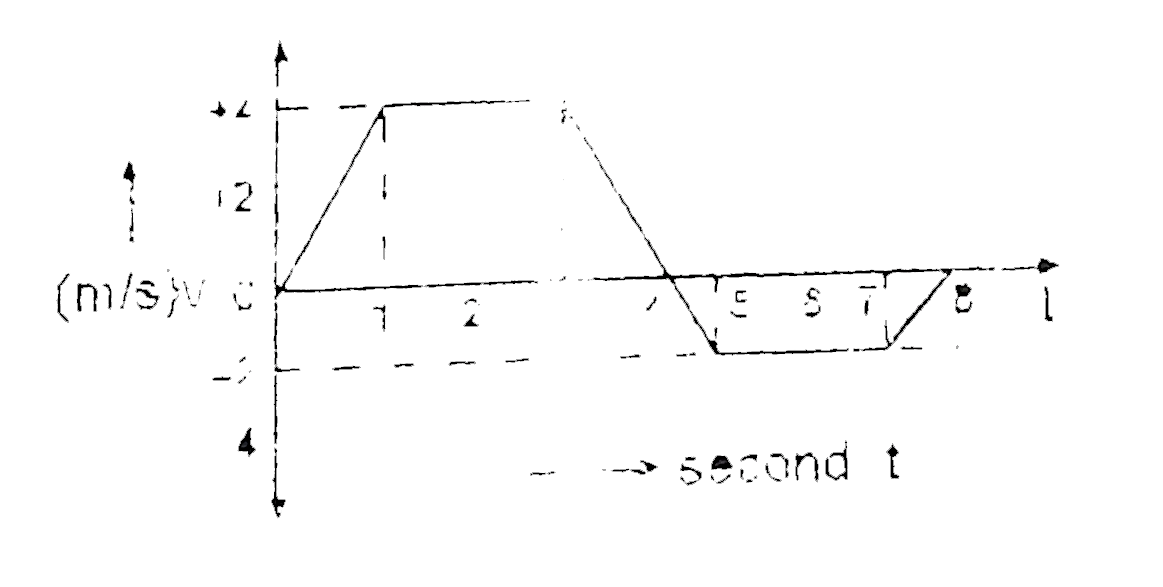Find the distance travelled by the particle during the time t = 0 to t = 3 second from the figure .
 Solution in Tamil
Solution in Tamil
Given :
Formula :
Distance s = Area of ΔOAB
=12×OA×BA
=12×3×6=9m
If the speed varies with the time :
Then , v=dsdt⇒ds=vdt
⇒∫ds=∫vdt
or s=∫cdt
Topper's Solved these Questions
- KINEMATICS BOOK - PREMIERS PUBLISHERSCHAPTER - KINEMATICS EXERCISE - Other important questions & answers (IV. Long answer questions).
34 Videos
- GRAVITATIONBOOK - PREMIERS PUBLISHERSCHAPTER - GRAVITATIONEXERCISE - OTHER IMPORTANT QUESTION & ANSWERS (CONCEPTUAL QUESTIONS)
34 Videos
- KINETIC THEORY OF GASESBOOK - PREMIERS PUBLISHERSCHAPTER - KINETIC THEORY OF GASESEXERCISE - OTHER IMPORTANT QUESTIONS & ANSWERS (VI. Conceptual Questions.)
8 Videos
Similar Questions
Define and illustrate the following terms.
Equal vectors.
View SolutionWhy a body weighs less at the equator than at the poles?
View SolutionWhen an automobile travels for a long distance , the air pressure in the tyres increases slightly . Why ?
View SolutionFigure shows the speed versus time graph for a particle. Find the distance travelled by the particle during the time t=0 to t=3s.

View SolutionThe position of a particle moving rectilinearly is given by x = t^3 - 3 t^2 - 10 . Find the distance travelled by the particle in the first 4 seconds starting from t = 0 .
View SolutionA particle is moving along the x-axis such that s=6t-t^(2) , where s in meters and t is in second. Find the displacement and distance traveled by the particle during time interval t=0 to t=5 s .
View SolutionThe velocity time graph of a particle moving along a straight line is shown in the figure. In the time interval from t=0 to t=8 second, answer the following three question.

The distance travelled by the particle is :
View SolutionThe distance travelled (in meters) by the particle from time to t = 0 to t = 1s will be –
View SolutionThe distance travelled (in meters) by the particle from time t = 0 to t = t will be –
View SolutionSuppose that a particle mvoes on a straight line so that is velocity at time t is v(t)=(t^(2)-2t)m//s . (a). Find the displacement of the particle during the time interval 0 le t le 3 (b). Find the distance traveled by the particle during the time interval 0 le t le 3 .
View Solutionthe velocity of a particle varies with time as shown below the distance travelled by the travelled by the particle during t=2s"and" t= 6s. Is
View Solutionसंलग्न चित्र में प्रदर्शित किसी कण के वेग समय ग्राफ से ज्ञात कीजिए-
(i) प्रथम 20 सेकण्ड में कण द्वारा तय दूरी एवं इसका विस्थापन।
(ii) t=20 से 40 सेकण्ड के बीच कण द्वारा तय दूरी एवं उसका विस्थापन।
(iii) प्रथम 40 सेकण्ड में कण द्वारा तय दूरी एवं इसका विस्थापन।
(iv) 0 से 20 सेकण्ड तक कण का औसत वेग, औसत चाल तथा औसत त्वरण।
(v) 0 से 10 सेकण्ड तक के अन्तराल में कण का औसत त्वरण।
(vi) t=0 सेकण्ड से 20 सेकण्ड के बीच कण का औसत त्वरण।
(vii) t=5 सेकण्ड पर कण का त्वरण।
(viii) t=20 सेकण्ड पर कण का त्वरण।

View Solutionएक कण का वेग समय ग्राफ चित्र में प्रदर्शित है। ज्ञात कीजिए।

(i) t=0 से t=5 सेकण्ड के समयान्तराल में कण का त्वरण।
(ii) t=5 से t=7 सेकण्ड के समयान्तराल में कण का त्वरण।
(iii) t=7 से t=10 सेकण्ड के समयान्तराल में कण का त्वरण।
(iv) t=0 से t=7 सेकण्ड के समयान्तराल में कण द्वारा तय दूरी।
(v) t=0 से t=10 सेकण्ड के समयान्तराल में कण द्वारा तय दूरी।
View Solutionएक कण t = 0 से चलना प्रारंभ करता है । t समय में कण द्वारा चली हुई दुरी s=(2.5m/s2)t2 से प्राप्त होती है । (a) समय t = 0 से 4 .0 तक में कण की औसत चाल बताएँ। (b) t = 4. 0 s पर कण की चाल बताएँ।
View SolutionFind the distance travelled by the particle during the time t = 0 to t = 3 second from the figure .
View SolutionThe speed verses time graph for a particle is shown in the figure. The distance travelled (in m) by the particle during the time interval t = 0 to t = 5 s will be __________
View Solution
